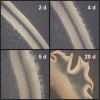The mosaic genome of Anaeromyxobacter dehalogenans strain 2CP-C suggests an aerobic common ancestor to the delta-proteobacteria
- PMID: 18461135
- PMCID: PMC2330069
- DOI: 10.1371/journal.pone.0002103
The mosaic genome of Anaeromyxobacter dehalogenans strain 2CP-C suggests an aerobic common ancestor to the delta-proteobacteria
Abstract
Anaeromyxobacter dehalogenans strain 2CP-C is a versaphilic delta-Proteobacterium distributed throughout many diverse soil and sediment environments. 16S rRNA gene phylogenetic analysis groups A. dehalogenans together with the myxobacteria, which have distinguishing characteristics including strictly aerobic metabolism, sporulation, fruiting body formation, and surface motility. Analysis of the 5.01 Mb strain 2CP-C genome substantiated that this organism is a myxobacterium but shares genotypic traits with the anaerobic majority of the delta-Proteobacteria (i.e., the Desulfuromonadales). Reflective of its respiratory versatility, strain 2CP-C possesses 68 genes coding for putative c-type cytochromes, including one gene with 40 heme binding motifs. Consistent with its relatedness to the myxobacteria, surface motility was observed in strain 2CP-C and multiple types of motility genes are present, including 28 genes for gliding, adventurous (A-) motility and 17 genes for type IV pilus-based motility (i.e., social (S-) motility) that all have homologs in Myxococcus xanthus. Although A. dehalogenans shares many metabolic traits with the anaerobic majority of the delta-Proteobacteria, strain 2CP-C grows under microaerophilic conditions and possesses detoxification systems for reactive oxygen species. Accordingly, two gene clusters coding for NADH dehydrogenase subunits and two cytochrome oxidase gene clusters in strain 2CP-C are similar to those in M. xanthus. Remarkably, strain 2CP-C possesses a third NADH dehydrogenase gene cluster and a cytochrome cbb(3) oxidase gene cluster, apparently acquired through ancient horizontal gene transfer from a strictly anaerobic green sulfur bacterium. The mosaic nature of the A. dehalogenans strain 2CP-C genome suggests that the metabolically versatile, anaerobic members of the delta-Proteobacteria may have descended from aerobic ancestors with complex lifestyles.
Conflict of interest statement
Figures





References
Publication types
MeSH terms
Substances
LinkOut - more resources
Full Text Sources
Molecular Biology Databases
Miscellaneous

